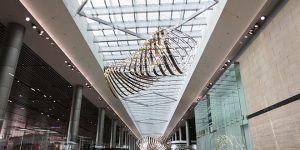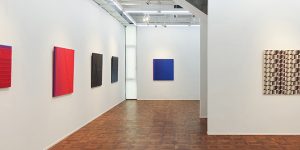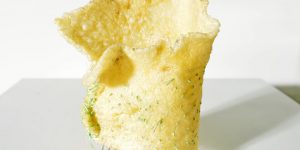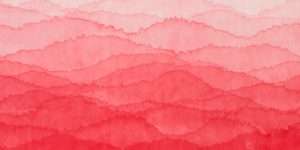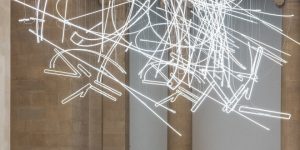Asian art market trends in the 21st-century
The re-emergence of modern artists

Oesman Effendi, ‘Awan Berarak’, 1971. Image courtesy Art Agenda S.E.A
Brett Gorvy, who made headlines in December when he left Christie’s to partner with top dealer Dominique Lévy once opined, “we are not art history, we are the art market”. The art market is brashly characterised here for emphasis. It is a domain with a yardstick onto itself, oriented only too eager loaded new entrants and ever spiralling prices, with a blatant disdain for history. Fortunately, much of the market has deeper regard for art history and remains equally exciting to operate in.
In particular, things couldn’t be more different in the case of the Asian art market. In the aftermath of the 2008 global financial crisis affecting the most severe consolidation of the market this present generation has seen, there, in fact, has been a perceptible shift from the heady and inherently speculative contemporary art market to the safer established modern arena. In simpler terms, a flight to history: history as told conservatively, and increasingly, history as re-discovered.
In the recovery trajectory of the Asian art market since 2010, numerous modern names who have largely been consigned to the sidelines of art history have been the beneficiaries of generous revisionist lens, from a whole legion of Japanese Gutai artists pushing for the interaction of material and spirit since the 1950s to the Korean Dansaekhwa minimalists of the 1970s and Singapore-based Nanyang artists marrying western and eastern art aesthetics in the immediate post-war decades.

Oesman Effendi, ‘Alam Pedesaan’, 1979. Image courtesy Art Agenda S.E.A
The impetus behind the exuberant (re)emergence of these modern artists and concomitant price spikes is due to a confluence of factors: from the present generation’s consciousness to revise mainstream art history to be more accommodative to the growing global appetite for the so-called ‘old but new guard’. People are searching within their own backyards for what they previously ignored, digging up ‘finds’ and placing them in comparative contexts that show up these things well. On this last point, the art market can look forward to more rediscovered species as experts and novices alike appreciate a diverse ecology in a truly globalised 21st-century world where connections transcend traditional boundaries.
A number of other art movements have in fact organically sprung up in different parts of Asia broadly parallel to Gutai and Dansaekhwa. At this moment, the art world has begun to pay interest in artists of the Taiwanese Fifth Moon Group. Founded in 1956 and actively exhibiting until 1970, the group was led by Liu Kuo-sung (b. 1932) and comprises of other like-minded 1930s and 40s born artists: Chuang Che (b. 1934), Chen Ting-Shih (b. 1916 – 2002) and Fong Chung Ray (b. 1933). In their individual ways, they sought to draw eclectically from the varied traditions of Chinese art while creating works within the contemporaneous framework of modern international painting.
In Indonesia, the story of abstract art has often been narrated as a counterpoint to realist art underlined by a populist ideology. Bandung, the city in West Java where the influence of Dutch colonial is still most apparent in present-day Indonesia, is often posited as the gathering point for artists exploring the –isms of early to mid-20th century western modern art, in opposition to the artists in the central Javanese city of Yogyakarta working in the service of the rakyat (commoner) and committed to reflecting the realities of daily life in their art. In fact, the story runs deeper if we choose to venture further. In the nation-building era of the 1960s, Indonesian artists of varied disciplines gathered around a government built cultural centre, Taman Ismail Marzuki (TIM) in the capital city of Jakarta. The sphere of influence exerted by TIM in that era – at least in the area of modern art – derived from a group of Sumatra born artists who were teaching art at Lembaga Pendidikan Kesenian Jakarta (LPKJ or the Jakarta Art Institute Association).

Nashar, ‘Tenaga Pergulatan’, 1983. Image courtesy Art Agenda S.E.A
Oesman Effendi (1919 – 1985), Zaini (1926 – 1977), Nashar (1928 – 1994), and Rusli (1916 – 2005) were contemporaries from the island of Sumatra who shared a common cultural and religious background in orthodox Islam. Each had left Sumatra for Yogyakarta in the 1940s and 1950s in pursuit of artistic advancement. They had individually become disenchanted with the dominant populist aesthetic paradigm in Yogyakarta at that time with political ties tending to the left. Gathering in the less polemical and less formalist-oriented environs of Jakarta, the four artists were active in art discourse and education and were the leading proponents for a non-representational, intuition-led and highly evocative branch of abstract painting.
Nature served as the point of departure for their works, but each of them sought to depict non-representational forms that are self-referential and pure onto themselves, even as these forms may allude to external reality. Parallel to other artists globally working in the post-war era, especially those tending towards abstraction, they eschewed illusionistic depth — a key tenet of Western painting since the Renaissance — for exploration on a flat picture plane. Released from the necessity of representation, they strove towards an experiential approach to painting.

Amrus Natalsya, ‘Melepas Dahaga (Quenching Thirst)’, 1962. Image courtesy Art Agenda S.E.A
The significance of the works of these four Sumatran artists is now just beginning to be appreciated. The art historian Helena Spanjaard recently included a revisionist chapter that began with profiling the works of the four artists in her monograph on Indonesian art, ‘Artists and Their Inspiration: A Guide Through Indonesian Art History (1930-2015)’. In the secondary market outside of the auctions, prices have also significantly appreciated, with a growing base of non-Indonesian buyers who are noticing the coherence in the aesthetic position espoused by these artists. And these may all very well signal an emerging strand in the broad and expanding field of abstract modern Asian art.
To mark ASEAN’s golden jubilee this year, the ASEAN Secretariat and ASEAN Foundation have organised a modern and contemporary art exhibition in partnership with Art Agenda, S.E.A, and DayaLima, supported by UOB Indonesia. Titled ‘Assemblage: Reflections on ASEAN’, the exhibition will explore the transformation that has taken place within the region throughout the years. It will run from July 28 to August 31 at ASEAN Gallery at Jalan Sisingamangaraja 70A, Jakarta.
ERRATUM: In Art Republik Issue 15, it was written that that Astri Wright was the author of ‘Artists and Their Inspiration: A Guide Through Indonesian Art History’, but it should have been Helena Spanjaard.
Wang Zineng is the market columnist for Art Republik. He is also the founder of Art Agenda, S.E.A.





